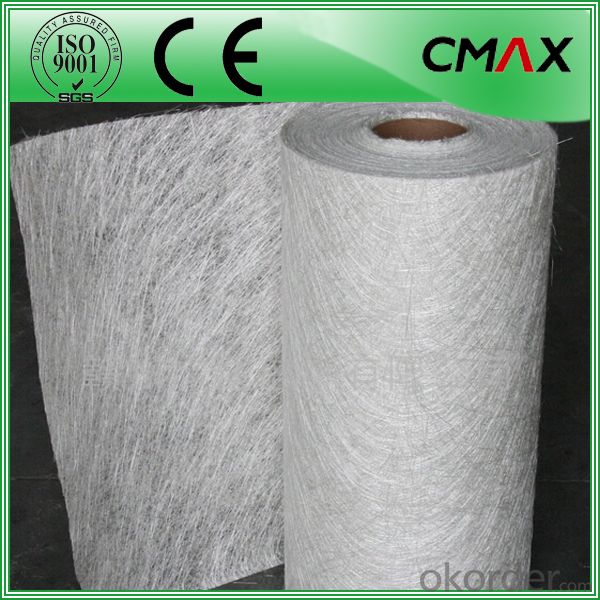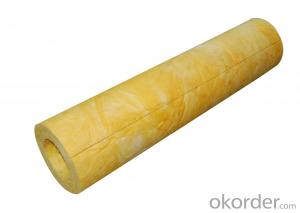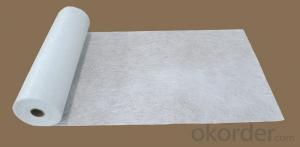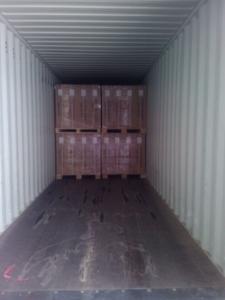Fiberglass Mat Tissue Standard Chopped Strand Mat FRP Skylight Fiberglass
- Loading Port:
- Shanghai
- Payment Terms:
- TT OR LC
- Min Order Qty:
- 1000 m.t
- Supply Capability:
- 1000000 m.t/month
OKorder Service Pledge
OKorder Financial Service
You Might Also Like
Standard Chopped Strand Mat FRP Skylight Fiberglass
Introduction:
Chopped Strand Mat is characterized by good combination of resin, easy operation, good wet strength retention, good laminate transparency and low cost. It is suitable for the application by hand lay-up FRP moldings, such as, various sheets and panels, boat hulls, boat tubs, cooling towers, corrosion resistant, vehicles, etc.
Function:
Fiberglass chopped strand mat is chopped using the "E" chopped glass and emulsion adhesive bond. It is suitable for hand lay and can enhance the unsaturaed ployester resins.
Product Features:
Consistent thickness and stiffness;
Rapid impregnating and good compatibility with resin;
Superior wet through with less air trap;
Good mechanical properties and high strength of parts.
Superior acid corrosion resistance
Technical Data:










Packaging:
Product is manufactured in form of a roll wrap on a paper tube then after packed in a plastic bag and placed in a cardboard carton. Rolls can be loaded in a container directly or on pallets.
Deposited:
Chopped Strand Mat should be stored in dry, cool, clean and rainproof area. Recommended temperature range of storage is between 15-30 and relative humidity between 40%-70%.



FAQ:
Is sample available ?
Yes, we provide the free samples, but customers themselves need pay the shipping fee
What's your MOQ?
Our MOQ is one 1*20' full container loading
How do you pack the fiberglass
(1) First, the mat is in roll packed in White PE fIlm.
(2) Then the rolls packed in the carton
4.Which knid of payment terms can you accept?
We can accept 30% prepayment, 70% payment before shippment. LC is also accepted
- Q: What are the factors that affect the diameter of electrospun nanofibers?
- High efficiency air filter, air filter (HEPA filter) is widely applied to the requirements of clean and sterile room (electronic goods and drug manufacturing sites, operation room) and other applications (such as air purifiers, vacuum bag filter and mask). Superfine glass fiber mat, melt blown (MB) fiber network, electrospun fiber mesh and ePTFE film and other media can reach...
- Q: Can fiberglass mat tissue be used for HVAC insulation?
- No, fiberglass mat tissue is not typically used for HVAC insulation. HVAC insulation usually requires materials that are specifically designed to have high thermal resistance and to prevent the transfer of heat or cold air. Fiberglass mat tissue is commonly used as a reinforcement material in the fabrication of composite materials, such as fiberglass panels or structures, rather than as insulation. Insulation materials for HVAC systems are typically made from materials like fiberglass insulation boards, foam insulation, or mineral wool, which have better thermal resistance properties and are specifically designed for HVAC applications.
- Q: Can fiberglass mat tissue be used for composite pipe manufacturing?
- Yes, fiberglass mat tissue can be used for composite pipe manufacturing. Fiberglass mat tissue provides reinforcement to the composite pipe, enhancing its strength, durability, and resistance to corrosion.
- Q: Can fiberglass mat tissue be used for aerospace applications?
- Yes, fiberglass mat tissue can be used for aerospace applications. It is commonly used as a reinforcing material in the aerospace industry due to its excellent mechanical properties, such as high strength-to-weight ratio and resistance to corrosion. Additionally, fiberglass mat tissue can provide thermal insulation and fire resistance, making it suitable for various aerospace components, including aircraft interiors, panels, and structural parts.
- Q: How is fiberglass mat tissue manufactured?
- Fiberglass mat tissue is manufactured through a multi-step process that involves the use of glass fibers and a binder material. The first step in the manufacturing process is the production of glass fibers. This is typically done by melting raw materials such as silica sand, limestone, and soda ash in a furnace. The molten glass is then forced through tiny holes in a spinneret, which creates fine strands of glass fibers. Once the glass fibers are produced, they are pulled together to form a continuous mat. This is achieved by passing the fibers through a series of rollers or air jets that align and compress the fibers into a uniform sheet. At this stage, the mat is still loose and fragile. To give the fiberglass mat tissue its strength and stability, a binder material is added. This binder can be a resin or a combination of resins and additives. The binder is typically sprayed onto the mat, allowing it to penetrate and bond with the glass fibers. This process is known as wet-laid manufacturing. After the binder is applied, the fiberglass mat tissue goes through a curing process. This can involve the use of heat, pressure, or both, depending on the specific requirements of the product. The curing process helps to harden the binder and ensure that it securely holds the glass fibers together, creating a strong and durable mat. Once the curing process is complete, the fiberglass mat tissue is dried to remove any excess moisture. It is then trimmed and cut into the desired dimensions. Depending on the intended application, the mat may undergo additional treatments such as surface coatings or laminations to enhance its performance properties. Overall, the manufacturing process of fiberglass mat tissue involves the production of glass fibers, the formation of a continuous mat, the addition of a binder material, curing, drying, and final processing. This process ensures that the resulting fiberglass mat tissue is strong, flexible, and suitable for a wide range of applications such as insulation, reinforcement in composites, or roofing materials.
- Q: Can fiberglass mat tissue be used for making electrical enclosures?
- No, fiberglass mat tissue cannot be used for making electrical enclosures. Electrical enclosures require materials that have high electrical insulation properties, such as non-conductive plastics or metals, to ensure safety and prevent electrical hazards.
- Q: Can fiberglass mat tissue be used in automotive manufacturing?
- Yes, fiberglass mat tissue can be used in automotive manufacturing. Fiberglass mat tissue is a lightweight, flexible material made from glass fibers that are bonded together with a binder. It is commonly used in the automotive industry for various applications such as reinforcing body panels, creating structural components, and improving sound and heat insulation. One of the main advantages of using fiberglass mat tissue in automotive manufacturing is its high strength-to-weight ratio. It provides excellent reinforcement properties while adding minimal weight to the vehicle, making it an ideal choice for achieving fuel efficiency and reducing emissions. Additionally, fiberglass mat tissue is highly moldable, allowing it to be easily shaped and formed into complex geometries required for automotive parts. This material can be used to reinforce areas that are susceptible to high stress, such as the roof, doors, and undercarriage, thereby enhancing the overall strength and durability of the vehicle. Moreover, fiberglass mat tissue offers excellent resistance to corrosion, chemicals, and extreme temperatures, making it suitable for use in diverse automotive environments. It is also an effective sound and heat insulator, helping to reduce noise and maintain a comfortable interior temperature. Overall, fiberglass mat tissue has proven to be a valuable material in automotive manufacturing due to its lightweight, strong, moldable, and durable properties. Its versatility and performance characteristics make it a preferred choice for many automotive manufacturers looking to enhance the quality and performance of their vehicles.
- Q: What are the potential health hazards associated with working with fiberglass mat tissue?
- Working with fiberglass mat tissue can pose several potential health hazards due to the nature of the material. One primary concern is the inhalation of fiberglass particles, which can cause respiratory issues. When fiberglass is cut or handled, it releases small particles into the air that can be easily inhaled. Prolonged exposure to these particles may lead to throat and lung irritation, coughing, and difficulty breathing. Another potential health hazard associated with fiberglass mat tissue is skin irritation. The tiny fibers from the material can irritate the skin upon contact, causing redness, itching, and rashes. In some cases, prolonged exposure or repeated contact with fiberglass can result in more severe skin conditions such as dermatitis. Furthermore, fiberglass mat tissue can also cause eye irritation and damage. If fibers come into contact with the eyes, they can cause redness, itching, watering, and even corneal abrasions. It is important to wear appropriate eye protection, such as goggles, to prevent any potential eye injuries while working with fiberglass. To mitigate these potential health hazards, it is crucial to follow safety guidelines and use personal protective equipment (PPE) when working with fiberglass mat tissue. This includes wearing a respirator mask to prevent inhalation of particles, using gloves and protective clothing to minimize skin contact, and wearing safety goggles to protect the eyes. Regular cleaning and good hygiene practices are also essential to minimize any potential health risks associated with fiberglass. It is important to clean work areas properly to remove any loose fibers, and to wash hands and exposed skin thoroughly after working with fiberglass. Overall, while working with fiberglass mat tissue can present potential health hazards, taking appropriate safety precautions and following safety guidelines can significantly reduce the risk of any adverse health effects.
- Q: Can fiberglass mat tissue be used for insulation in power plants?
- Yes, fiberglass mat tissue can be used for insulation in power plants. It is a common material used for thermal insulation due to its excellent heat resistance and insulation properties.
- Q: What is the lifespan of fiberglass mat tissue?
- The longevity of fiberglass mat tissue can differ based on a range of elements, including material quality, exposure conditions, and maintenance level. Nevertheless, fiberglass mat tissue is generally recognized for its resilience and extended lifespan. By ensuring correct installation and consistent upkeep, fiberglass mat tissue can endure for numerous decades. Its resistance to corrosion, moisture, and UV radiation further contributes to its longevity. Furthermore, fiberglass mat tissue is frequently employed in roofing, insulation, and reinforcement applications, engineered to withstand challenging environments and deliver enduring effectiveness.
Send your message to us
Fiberglass Mat Tissue Standard Chopped Strand Mat FRP Skylight Fiberglass
- Loading Port:
- Shanghai
- Payment Terms:
- TT OR LC
- Min Order Qty:
- 1000 m.t
- Supply Capability:
- 1000000 m.t/month
OKorder Service Pledge
OKorder Financial Service
Similar products
Hot products
Hot Searches
Related keywords

































